KBK Crane and Crane System
KBK Crane for Sale, KBK Crane System Design for You 1 Ton, 2 Ton
KBK crane for sale. All types of kbk cranes with kbk track or truss girder, single girder & double girder, ceiling mounted & freestanding design for sale.
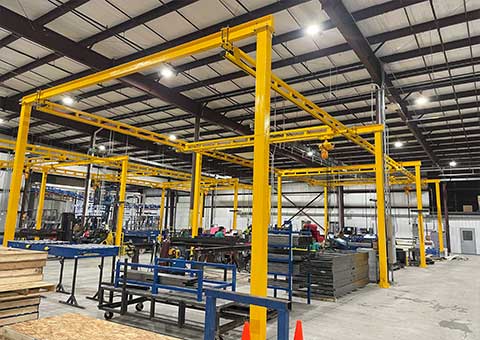

KBK crane for sale. All types of kbk cranes with kbk track or truss girder, single girder & double girder, ceiling mounted & freestanding design for sale.

The term "KBK" originates from the German acronym "Kranbahnsysteme," translating to "crane runway system" in English. Rooted in German engineering prowess, KBK Crane is synonymous with cutting-edge technology that has evolved to redefine material handling standards globally.
Main Specifications of kbk KBK Crane Systems
Applications with lighter loads (less than 2000 Kg): Parts Assembly,Machining,Palletizing loads,Injection Molding,Warehouse loading docks,Process Equipment Maintenance,Truck Service Centers, etc.
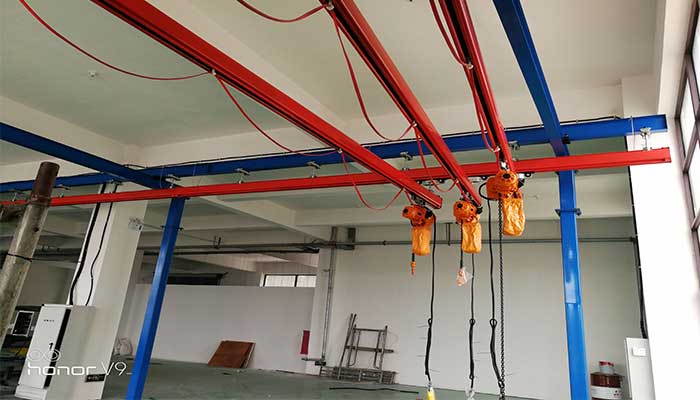 Single-Girder KBK Crane
Single-Girder KBK Crane
The Single-Girder KBK Crane is a testament to the elegance of simplicity combined with robust design. Engineered for efficiency, its single-girder structure ensures a streamlined and straightforward design, emphasizing precision in material handling.
Appropriate Load Capacities: Tailored Strength for Varied Needs
One of the standout features of the Single-Girder KBK Crane is its versatile load-bearing capabilities. Ranging from lightweight to moderate loads, it finds its stride in applications demanding precise handling within its designated capacity.
Key Features and Benefits: Elevating Material Handling Efficiency
Compact Design: The single-girder configuration allows for enhanced maneuverability in confined spaces, making it an ideal choice for workshops and production cells.
Quick Installation: With a focus on efficiency, the single-girder KBK Crane boasts a swift installation process, minimizing downtime and maximizing productivity.
Ease of Maintenance: Designed with user convenience in mind, maintenance is streamlined, ensuring optimal performance over the crane's lifecycle.
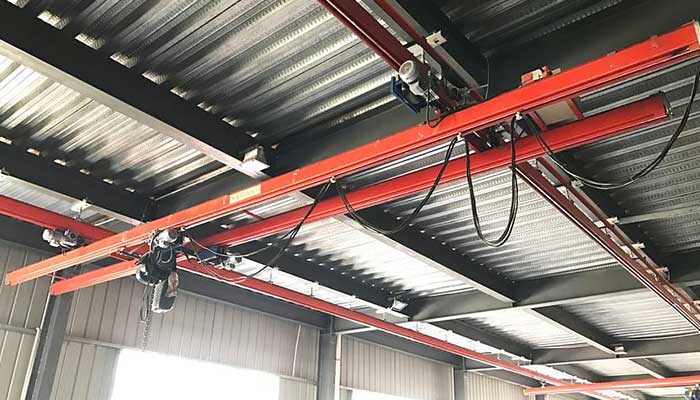
Double-Girder KBK Cranes
Enhanced Load Capacities: Empowering Heavy-Duty Material Handling
In the realm of heavy-duty lifting, the Double-Girder KBK Crane takes center stage. Boasting increased load capacities, it becomes the go-to choice for applications demanding the handling of substantial weights with precision and reliability.
Superior Stability and Precision: Redefining Material Handling Dynamics
With a dual-girder setup, this crane configuration achieves superior stability. This not only enhances safety in material handling but also elevates precision, ensuring that each movement is executed with the utmost accuracy.
Common Applications: Versatility Across Industries
From manufacturing plants to construction sites, the Double-Girder KBK Crane proves its mettle in diverse applications. Its adaptability makes it a staple in industries requiring a robust solution for heavy load handling.
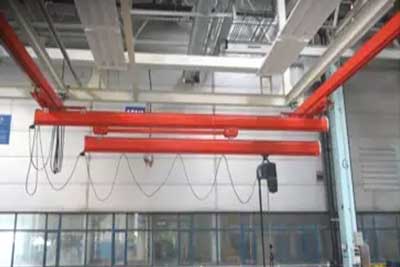 Articulated KBK Cranes
Articulated KBK Cranes
Flexibility in Movement: Adapting to Dynamic Work Environments
Articulated KBK Cranes redefine the rules of movement. Their flexibility allows for a wide range of motion, adapting seamlessly to dynamic work environments where precision and adaptability are paramount.
Ideal for Complex Work Environments: Tackling Challenges with Ease
In settings where traditional cranes may face limitations, articulated KBK cranes excel. Their ability to navigate complex spaces makes them an ideal choice for workshops and facilities with intricate layouts.
Real-world Use Cases: Unleashing Articulated Precision
From assembly lines with intricate processes to laboratories requiring delicate handling, articulated KBK cranes find their niche. Their versatility positions them as a solution for a myriad of real-world challenges.
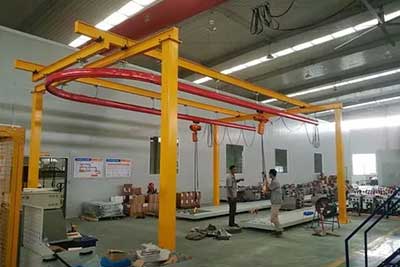
Monorail KBK Crane Systems
Efficient Linear Movement: Streamlining Material Flow
The Monorail KBK Crane System introduces a linear approach to material handling. Its efficient movement along a single track optimizes material flow, reducing unnecessary stops and enhancing overall productivity.
Space-Saving Design: Maximizing Facility Utilization
In facilities where space is a premium, the monorail design becomes a strategic choice. The compact layout of the Monorail KBK Crane System ensures optimal space utilization without compromising on efficiency.
Applications in Various Industries: Tailoring Solutions to Industry Needs
From warehousing to manufacturing, the Monorail KBK Crane System finds applications across diverse industries. Its adaptability and linear movement make it a versatile solution for streamlined material handling.
Truss type KBK cranes refer to a type of KBK (Kettenzug-Brücken-Kran, German for Chain Hoist Bridge Crane) crane that features a truss girder design. The truss girder is a structural framework composed of triangular units, known as trusses, that provide stability and strength to the crane while minimizing the overall weight. The truss design is well-suited for applications where a lightweight yet sturdy structure is required.
The main types of KBK cranes with a truss girder include:
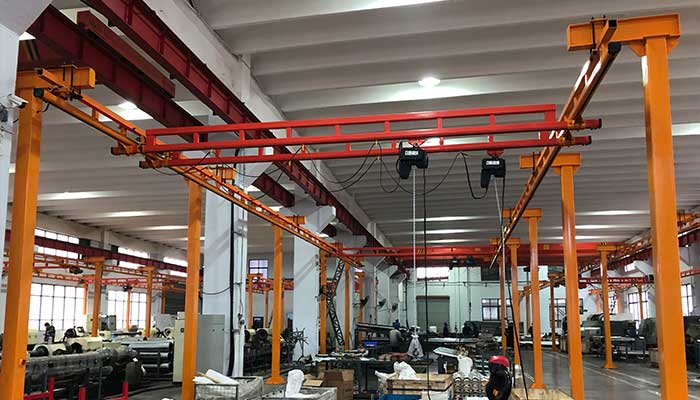 Single-Girder Truss KBK Cranes:
Single-Girder Truss KBK Cranes:
This type of KBK crane features a single truss girder that spans the width of the crane. It is commonly used for light to moderate load capacities and offers flexibility in movement along the runway. Single-girder truss KBK cranes are suitable for applications in workshops, warehouses, and assembly lines.
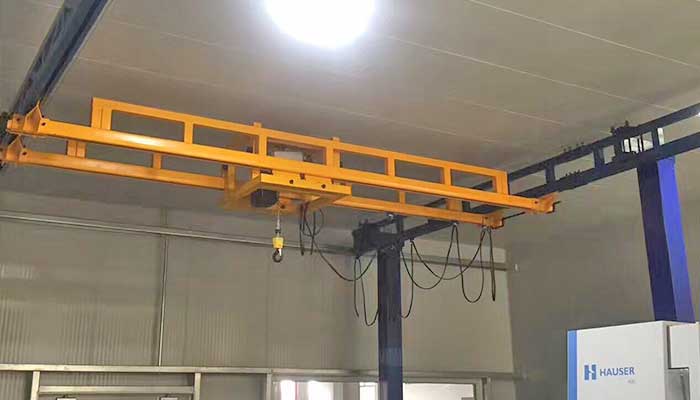 Double-Girder Truss KBK Cranes:
Double-Girder Truss KBK Cranes:
Double-girder truss KBK cranes have two truss girders running parallel to each other, providing increased stability and load capacity. These cranes are suitable for heavier loads and more demanding applications. Double-girder truss KBK cranes are often used in industries such as manufacturing, heavy machinery production, and construction.
The truss girder design in KBK cranes offers advantages such as reduced weight, increased strength, and flexibility in customization. It allows for the efficient handling of loads while minimizing structural demands, making truss-type KBK cranes versatile and well-suited for a wide range of material handling applications.
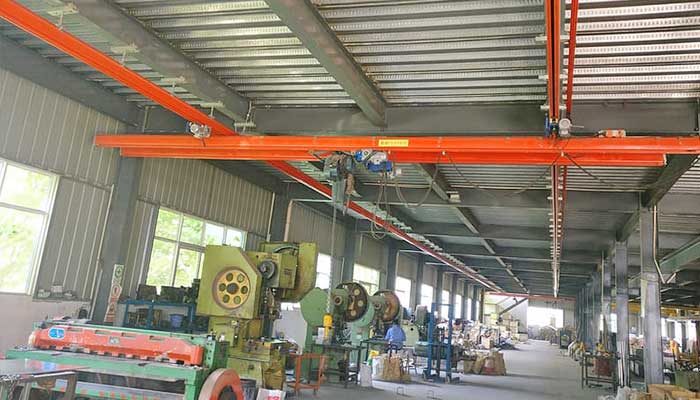
Ceiling-Mounted KBK Crane:
Description: Ceiling-mounted KBK cranes are attached to the ceiling structure of a building. The crane runway is typically suspended from the ceiling, allowing the crane to move horizontally along the designated path.
Advantages:
Maximizes floor space: Since the crane is mounted on the ceiling, it leaves the floor clear for other activities.
Provides flexible coverage: Ceiling-mounted KBK cranes can cover a large area, and their movement is not restricted by obstacles on the ground.
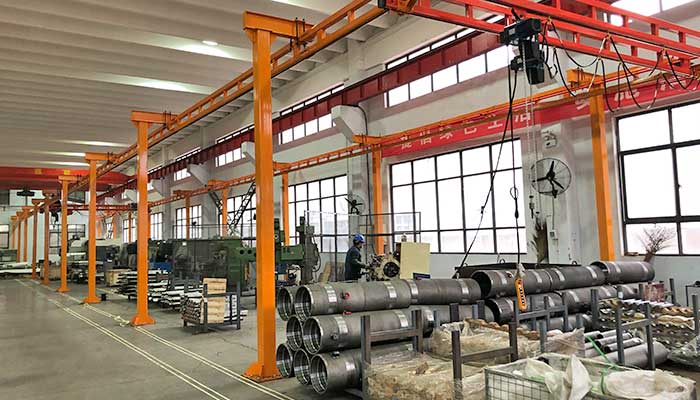
Free-Standing KBK Crane:
Description: Free-standing KBK cranes are supported by their own structure, which is independent of the building's ceiling. These cranes are often mounted on freestanding columns or pillars.
Advantages:
Versatile placement: Free-standing KBK cranes can be installed in locations where ceiling-mounted cranes are not practical or possible.
Easy to install: They do not require attachment to the building structure, simplifying the installation process.
Each mounting type has its own set of advantages, and the choice between ceiling-mounted and free-standing KBK cranes depends on factors such as facility layout, available space, and specific material handling requirements. The goal is to optimize the crane system for efficient and safe material handling within the given workspace.
Adaptable Design for Specific Needs
The cornerstone of KBK Crane technology lies in its modularity. The system is meticulously designed to be adaptable, allowing for the customization of configurations tailored to specific material handling needs. Whether your requirements evolve or your facility undergoes changes, the KBK Crane System seamlessly grows with you.
Easy Expansion and Modification
In the fast-paced world of industry, adaptability is key. The modularity of KBK Cranes extends beyond initial installations—expansion and modification become straightforward processes. With minimal disruptions, the system transforms to accommodate the changing dynamics of your operations.
Lightweight Construction
Reduced Structural Load
KBK Cranes redefine the relationship between strength and weight. The lightweight construction of the system minimizes the structural load on your facility, ensuring that the focus remains on efficient material handling without compromising the integrity of your infrastructure.
Increased Maneuverability
Where traditional cranes may face limitations, KBK Cranes shine. The lightweight design enhances maneuverability, allowing for precision in movement. Navigating confined spaces becomes a seamless endeavor, contributing to heightened operational efficiency.
Smooth and Precise Movements
Precision Handling of Loads
At the heart of KBK Crane technology is the commitment to precision. The system's design facilitates the smooth and precise handling of loads, ensuring that each movement is executed with accuracy. This level of control is instrumental in industries where precision is non-negotiable.
Minimal Vibrations and Noise
KBK Cranes introduce a new era of tranquility in material handling. The design minimizes vibrations and noise during operations, creating a conducive work environment. This focus on minimizing disturbances aligns with the principles of workplace safety and comfort.
Ease of Installation and Maintenance
Quick Installation Process
Time is of the essence, and KBK Cranes acknowledge this reality. The installation process is streamlined for efficiency, reducing the time required for deployment. Quick installation means faster integration into your operations.
Minimal Downtime for Maintenance
Maintenance is a part of ensuring continuous and reliable operations. KBK Cranes prioritize ease of maintenance, minimizing downtime during servicing or inspections. This proactive approach to maintenance ensures that your operations remain uninterrupted.
As we unravel the distinctive features and benefits of KBK Crane and KBK Crane System, stay tuned for the next segment where we explore the practical applications of these technological marvels. The journey into precision and adaptability in material handling continues, with KBK at the forefront of innovation.
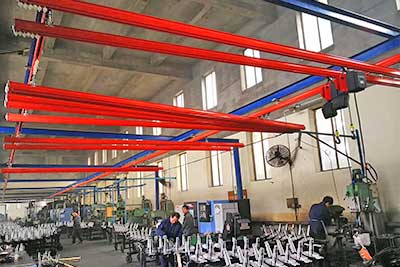
Single-Girder KBK Cranes
Assembly Lines in Automotive Plants
In the bustling environment of automotive plants, efficiency is paramount. Single-Girder KBK Cranes find their niche on assembly lines, precisely handling components with the agility required in the automotive manufacturing process.
Small Parts Handling in Electronics Industry
The delicate nature of electronic components demands a crane system that embodies finesse. Single-Girder KBK Cranes shine in the electronics industry, delicately handling small parts with the precision required in the assembly of intricate electronic devices.
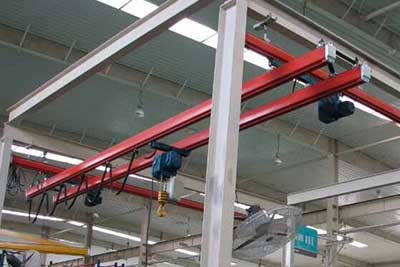
Double-Girder KBK Cranes
Heavy Machinery Manufacturing
When it comes to heavy machinery, precision and stability are non-negotiable. Double-Girder KBK Cranes take the lead in heavy machinery manufacturing, effortlessly handling substantial loads with the stability required in the production of robust machinery.
Shipbuilding and Large Component Handling
In the expansive realm of shipbuilding, where components are colossal, the Double-Girder KBK Crane proves its mettle. Its enhanced load capacities and stability make it the ideal choice for maneuvering and positioning large components in ship construction.

Articulated KBK Cranes
Confined Spaces in Workshops
Workshops often pose challenges with confined spaces and intricate layouts. Articulated KBK Cranes excel in such environments, navigating with flexibility and precision to handle materials in spaces where traditional cranes might struggle.
Overhead Handling in Laboratories
Laboratories demand a crane system that aligns with the precision required for delicate equipment handling. Articulated KBK Cranes take on the challenge, providing overhead solutions for laboratories where precise movements are essential.

Monorail KBK Crane Systems
Warehousing and Logistics
In the fast-paced world of warehousing and logistics, efficiency in material flow is critical. Monorail KBK Crane Systems streamline this process, efficiently transporting goods along a single track to optimize storage and retrieval operations.
Continuous Material Flow in Manufacturing
Manufacturing processes often rely on a continuous flow of materials. The linear movement of Monorail KBK Crane Systems proves beneficial in manufacturing, ensuring a steady and efficient material flow within the production environment.
As we delve into the industrial applications of KBK Crane and KBK Crane System, the versatility and adaptability of this technology become increasingly evident. In our next segment, we'll address the top concerns of users, ensuring a holitic exploration of KBK Crane technology from safety measures to reliability and adaptability. Join us as we navigate the landscape where KBK innovation meets the unique needs of industries worldwide.
Safety Measures and Compliance
Ensuring Operator and Workplace Safety
Safety is paramount in the world of material handling, and KBK Cranes are designed with a steadfast commitment to ensuring the well-being of operators and maintaining a safe workplace environment. Rigorous safety protocols and features are integrated to mitigate potential risks, ensuring that every operation is executed with the highest regard for safety.
Adhering to Industry Standards
In an ever-evolving industrial landscape, adherence to industry standards is non-negotiable. KBK Crane Systems are crafted in accordance with stringent standards, providing users with the assurance that their operations align with the best practices and regulations set forth by relevant industries.
Reliability and Durability
Long-Term Performance and Robust Construction
Reliability is the cornerstone of KBK Crane technology. These systems are engineered for long-term performance, leveraging robust construction to withstand the rigors of industrial applications. Users can trust in the enduring capabilities of KBK Cranes, ensuring consistent and reliable operation throughout their lifecycle.
Reduced Downtime and Maintenance Costs
Acknowledging the significance of uninterrupted operations, KBK Cranes are designed for minimal downtime. The emphasis on ease of maintenance translates to reduced costs associated with servicing and repairs, contributing to the overall efficiency and cost-effectiveness of KBK Crane Systems.
Adaptability to Industry Needs
Customization to Suit Specific Applications
Industries are diverse, and so are their material handling requirements. KBK Crane Systems rise to the challenge by offering customization options, allowing users to tailor their crane solutions to suit specific applications. This adaptability ensures that KBK technology seamlessly integrates into various industrial settings.
Flexibility to Accommodate Future Changes
In an era of constant evolution, the adaptability of KBK Crane Systems extends beyond current needs. These systems are designed with the flexibility to accommodate future changes in operations or facility layouts, providing users with a sustainable solution that grows with the dynamic nature of their industry.
Unveiling Solutions: The KBK Commitment
As we delve into the top concerns of KBK Crane and KBK Crane System users, it becomes clear that KBK technology is not just about precision in material handling but also about addressing the fundamental needs and apprehensions of users. In the upcoming segment, we'll explore frequently asked questions (FAQs) to provide comprehensive insights into the practical aspects of KBK Crane technology. Join us as we embark on a journey of clarity and understanding.
What Load Capacities Are Suitable for Different KBK Crane Types?
Precision in Load Handling
KBK Crane types cater to a spectrum of load capacities, ensuring a tailored solution for every need.
Single-Girder KBK Cranes: Ideal for lightweight to moderate loads.
Double-Girder KBK Cranes: Designed to handle substantial loads with enhanced stability.
Articulated KBK Cranes: Varied capacities, adapting to specific application requirements.
Monorail KBK Crane Systems: Efficiently transporting loads along a single track.
How Can KBK Crane Systems Improve Warehouse Efficiency?
Optimizing Warehouse Operations
KBK Crane Systems bring a multitude of benefits to warehouse environments.
Efficient Material Flow: Streamlining storage and retrieval processes.
Space Utilization: Maximizing storage capacity with a compact crane design.
Reduced Handling Time: Enhancing overall efficiency through precise material handling.
What Safety Features Are Integrated into KBK Cranes?
Commitment to Safety
KBK Cranes prioritize operator and workplace safety through advanced safety features.
Overload Protection: Preventing the crane from lifting loads beyond its capacity.
Emergency Stop Functionality: Quickly halting operations in critical situations.
Collision Avoidance Systems: Minimizing the risk of collisions in busy workspaces.
Can KBK Crane Systems Be Retrofitted for Existing Facilities?
Flexibility in Integration
KBK Crane Systems offer adaptability for retrofitting into existing facilities.
Modular Design: Easily integrating into various layouts and structures.
Customization: Tailoring the system to fit specific spatial and operational requirements.
Minimal Disruption: Retrofitting with minimal downtime, ensuring continuity in operations.
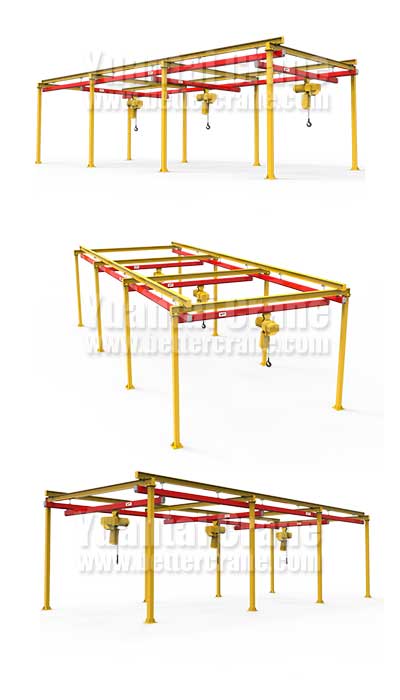 Custom kbk design for you application, 3d presentation is provided before production based on requirements
Custom kbk design for you application, 3d presentation is provided before production based on requirementsAs we navigate through frequently asked questions (FAQs) on KBK Crane and KBK Crane System, it becomes evident that clarity is at the forefront of our commitment. The KBK knowledge hub is a space where questions find answers and where solutions meet understanding. In the final installment of our exploration, we will conclude with closing remarks as a KBK Crane System manufacturer and supplier. Join us as we encapsulate the essence of KBK innovation and excellence.
Getting customized KBK cranes for your specific applications involves a collaborative process with a reputable KBK crane manufacturer or supplier. Here are the general steps you can follow to ensure you get a customized KBK crane tailored to your needs:
Identify Your Material Handling Requirements:
Clearly define your material handling needs, including load capacities, types of materials, required movement range, and any specific environmental conditions. Determine the key specifications that the customized KBK crane must meet.
Select a Reputable KBK Crane Manufacturer/Supplier:
Research and choose a reliable KBK crane manufacturer or supplier with a proven track record in providing customized solutions. Look for companies with experience in your industry and positive customer reviews.
Consultation and Site Assessment:
Engage in consultations with the KBK crane provider. Share details about your facility, workflow, and specific material handling challenges. Some providers may offer on-site assessments to better understand your requirements.
Customization Options Discussion:
Discuss customization options available for KBK cranes, such as:
Load Capacity, Span and Coverage, Runway Configuration, Control Systems, Special Features, etc.
Engineering and Design Phase:
The KBK crane provider's engineering team will work on designing a solution based on your requirements. This may include 3D modeling and simulations to ensure the crane meets your specifications.
Review and Approval:
Review the proposed design and specifications provided by the KBK crane manufacturer. Provide feedback and make any necessary adjustments. Once you are satisfied, give your approval for the customized solution.
Manufacturing and Assembly:
The manufacturer will proceed with the manufacturing and assembly of the customized KBK crane based on the approved design. Quality control processes should be in place to ensure the crane meets industry standards.
Installation and Commissioning:
The KBK crane will be installed and commissioned at your facility. This involves setting up the crane, testing its functionality, and ensuring that it meets safety standards.
Training and Support:
Training sessions for operators and maintenance staff may be provided to ensure the safe and efficient use of the customized KBK crane. Ongoing support and maintenance services should also be part of the package.
Continuous Improvement:
Work with the KBK crane provider to establish a relationship for ongoing support and potential future improvements or modifications based on changing needs.
To obtain an accurate KBK crane quotation, you'll need to provide detailed information about your specific requirements and the conditions in which the crane will operate. The following are the main parameters that KBK crane manufacturers or suppliers typically need for generating a quotation:
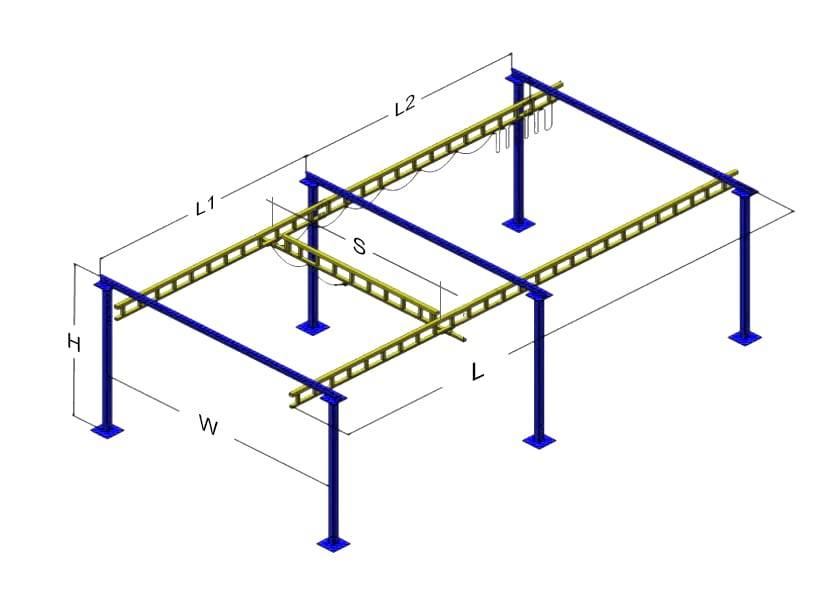
Load Capacity: - Specify the maximum weight that the KBK crane will need to lift and move. This is a crucial factor in determining the crane's design and components.
Span Length: - Indicate the distance or span the crane needs to cover horizontally. This helps in determining the size of the crane runway and the appropriate length of the KBK crane system.
Lifting Height: - Specify the vertical lifting height required for the KBK crane. This parameter is essential for designing the crane's lifting mechanism and ensuring it meets the height requirements of your facility.
Runway Length and Configuration: - Determine the length and layout of the crane runway. This includes information about whether the crane will be ceiling-mounted, free-standing, or monorail, as well as any curves or switches in the runway system.
Control System: - Specify the type of control system you prefer for the KBK crane. Common options include pendant control, radio remote control, or advanced automation systems. The control system choice depends on your operational preferences and safety requirements.
Environmental Conditions: - Provide details about the operating environment, including temperature ranges, humidity levels, and any exposure to corrosive substances. This information helps in selecting appropriate materials and coatings for the crane components.
Duty Cycle and Frequency of Use: - Indicate how frequently the KBK crane will be in operation and the duty cycle it needs to support. This information assists in determining the appropriate crane design and components to ensure durability and reliability.
Special Requirements: - If there are any specific features or requirements, such as specialized end-effectors, anti-collision systems, or automation capabilities, provide details to ensure these are incorporated into the design.
Installation Site Details: - Share information about the installation site, including available space, structural considerations, and any restrictions that may affect the installation and operation of the KBK crane.
Regulatory Compliance: - Ensure that the KBK crane design complies with relevant safety and regulatory standards in your region or industry. This may include requirements from occupational safety authorities or specific industry standards.
Budget Constraints: - If you have a budget limitation, communicate it to the KBK crane provider. This helps in tailoring the solution to meet your requirements within the specified budget.
By providing detailed and accurate information about these parameters, you enable the KBK crane manufacturer or supplier to generate a comprehensive and precise quotation that aligns with your specific material handling needs.
With more specific parameters, we can get your customized kbk crane and crane system for you. Check what we can do to save your kbk crane cost for your now.
KBK crane for sale. All types of kbk cranes with kbk track or truss girder, single girder & double girder, ceiling mounted & freestanding design for sale. How to get your custom kbk crane design? Contact us now!
Need Latest Crane Price? Please leave us the required Crane's Capacity, Lifting Height, Span, Travelling Length & Voltage for Quick Quotation.